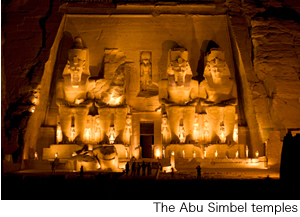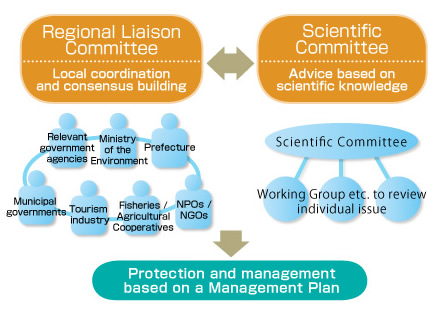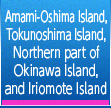- Ministry of the Environment>Nature & Parks>
- World Natural Heritage in Japan>
- What is World Heritage?
Origin of the World Heritage Convention
In the 1960s, as part of a plan to rescue historical monuments from the flooding produced by the construction of the Aswan High Dam on the Nile River, the United Nations Educational, Scientific and Cultural Organization (UNESCO) initiated an international safeguarding campaign to preserve the Nubian Monuments by dismantling and reassembling them. This action prompted the idea of protecting world cultural assets through international cooperation. In 1965, the United States of America suggested an international framework to support listing and protection of the world's superb natural and scenic areas and historic sites.
In the wake of such movements, the Convention Concerning the Protection of the World Cultural and Natural Heritage (World Heritage Convention) was adopted at a UNESCO General Conference in November 1972. Japan became a party to the Convention in 1992.

Outline of the World Heritage Convention
| Official name | Convention Concerning the Protection of the World Cultural and Natural Heritage |
|---|---|
| Objectives | The World Heritage Convention aims to identify, protect, conserve, present and transmit to future generations cultural and natural areas around the world considered to be of outstanding value. The Convention also supports to establish systems for international cooperation. |
| Secretariat | UNESCO World Heritage Centre (Paris) |
| What is World Heritage? |
World Heritage properties are the sites of Outstanding Universal Value (i.e. of particularly important value for all humankind) that are evaluated by the World Heritage Committee* as assets to be inscribed on the World Heritage List and be conserved into the future. There are natural properties, cultural properties, and mixed properties that have both natural and cultural values. |
*An intergovernmental body established under UNESCO, consisting of representatives of 21countries elected from the State Parties. A Committee term is limited to a maximum of 6 years (some countries voluntarily shorten their terms to 4 years)
(as of Mar 2022)
State Parties: 194 countries
Number of the World Heritage properties
| Total | 1154 | (25) |
|---|---|---|
| Natural heritage | 218 | (5) |
| Cultural heritage | 897 | (20) |
| Mixed heritage | 39 | (0) |
*Figures in parentheses are numbers for Japan.
Requirements for Inscription on the World Heritage List as a Natural Property
The Outstanding Universal Value of the property is evaluated in accordance with the following three conditions:
- The property must meet more than one of the four evaluation criteria (see table at right)
- The property must fulfill the condition of integrity (e.g. include all the elements necessary to demonstrate outstanding universal value; contain adequate areas; show little influence of development; and maintain its primary natural value).
- The property must be adequately protected and managed in order to maintain its outstanding universal value over the long term.
Those properties that fulfill the above conditions can be inscribed on the World Heritage List, as they are the only places in the world that have such significant value.
Criteria for World Heritage (natural property)
To be inscribed on the World Heritage List as a natural heritage, the property must meet one or more of the four criteria: natural beauty; geology and geomorphology; ecosystem; and biodiversity.
| (vii) natural beauty |
contain superlative natural phenomena or areas
of exceptional natural beauty and aesthetic
importance. |
|---|---|
| (viii) geology and geomorphology |
be outstanding examples representing major stages of earth's history, including the record of life, significant on-going geological processes in the development of landforms, or significant geomorphic or physiographic features. |
| (ix) ecosystem |
be outstanding examples representing significant
on-going ecological and biological processes
in the evolution and development of terrestrial,
fresh water, coastal and marine ecosystems and
communities of plants and animals. |
| (x) biodiversity |
contain the most important and significant natural
habitats for in-situ conservation of biological
diversity, including those containing threatened
species of Outstanding Universal Value from the
point of view of science or conservation. |
Process for the inscription of the properties on the World Heritage List
1 The State Party submits the Tentative List to the UNESCO World Heritage Centre (by 1 year before the nomination).
2 The State Party submits the nomination dossier to the UNESCO World Heritage Centre.
3 The International Union for Conservation of Nature (IUCN), an advisory body to the World Heritage Committee, conducts a field mission and external review of the documents, and produces a technical evaluation report containing a recommendation.
4 The World Heritage Committee (held once a year) determines whether to inscribe the property on the World Heritage List.
Protection and Management of Natural World Heritage Properties in Japan
Natural World Heritage properties must be appropriately protected and managed to maintain their values into the future. For this reason, protection and management measures in accordance with the national laws and systems are taken on those properties, through the status of National Parks, Nature Conservation Areas, Forest Ecosystem Reserves, and/or Natural Monuments for which the government has the management responsibility.
Framework for Protection and Management of Natural World Heritage Properties in Japan
On the natural World Heritage properties, appropriate protection and management is necessary to be implemented on the basis of scientific knowledge and with close cooperation among relevant parties, including local organizations, academic experts, and government bodies that have jurisdiction over protection and management of the natural environment. For each World Heritage property, a Regional Liaison Committee and Scientific Committee are established and operate to develop a Management Plan and advance protection and management efforts for that property.
| Regional Liaison Committee |
The Regional Liaison Committee is comprised of the Ministry of the Environment, Forestry Agency, local governments and other relevant parties. The committee serves as a vehicle for liaison and coordination and consensus building for management of the World Heritage property. |
|---|---|
| Scientific Committee |
The Scientific Committee is composed of experts in the natural and social sciences. On the basis of scientific knowledge, the committee provides the advice for appropriate protection and management of the property. |
| Management Plan |
The Management Plan clearly lays out policies and structures promoting the application of various schemes for protection and management. The appropriate protection and management programs are promoted through close cooperation and consultation among relevant stakeholders. |

Links
- UNESCO World Heritage Centre (link)
- World Heritage List Shiretoko (link)
- World Heritage List Shirakami-sanchi (link)
- World Heritage List Ogasawara Islands (link)
- World Heritage List Yakushima (link)
- World Heritage List Amami-Oshima Island, Tokunoshima Island, Northern part of Okinawa Island, and Iriomote Island (link)







